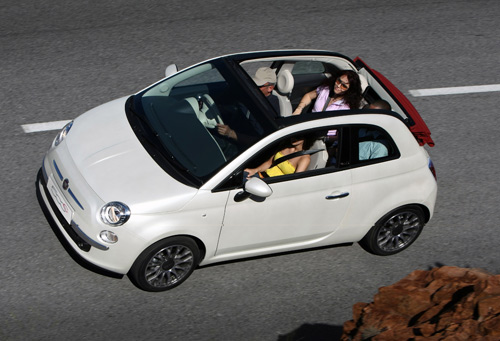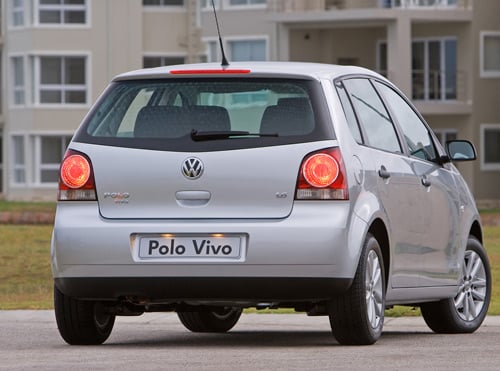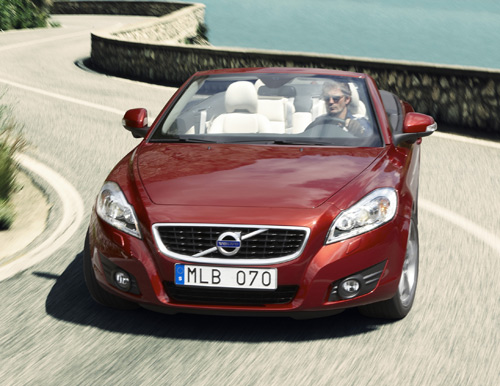Bill Bryson called the pickup truck the world’s first beer-guided automobile. If that’s the case then the Citroen C3 must undoubtedly be the world’s first Bacardi-and-Coke mobile.
Citroens and most small French cars in South Africa have been the reserve of female customers and on the face of it the latest C3 seems to be much of the same. This is why in my evaluation I must endeavour to steer clear of any testosterone-addled power, torque and handling references as possible.
So does the new Citroen C3 stack up for the ladies? Well, it’s funky and frothy, and on styling alone it has great forecourt appeal. It’s the first small car to come around since the Ford Fiesta that puts a grin on your face. Top-of-the-range C3 Seduction and Exclusive models have all the bells and whistles like the tall zenith windscreen and chrome detailing and those are the ones that will draw the eye.
But it’s the two entry-level Attraction models below them that come standard with leather steering wheel, trip computer, electric front windows, air conditioning and comfy upholstered seats. So they’re perfect for someone wanting a nearly fully loaded, entry-level car. Personally, as a fan of the vintage Citroen lunacy, I was expecting some crazy, young funkiness from the newest C3, and it’s more neat and tidy than I had hoped. The top two models cut the mustard for cool. But the volume sellers are pretty plain and they feel identical to a Peugeot 207.

The C3 is superbly built and quiet, which may come as a surprise to those who knew the plastic fantastic mess that was the interior of the previous C3. It’s spacious inside and the C3 feels grown up for a Citroen. Lots of the components come from Peugeot and, if I’m honest, I found myself forgetting I was in a Citroen quite often because of that.
Driving wise, the new Citroen C3 really has nothing to complain about. I’d definitely avoid the 54kW entry-level engine, but both the 70kW, 1.4-litre and 88kW 1,6-litre motors are economical, using a claimed figure of 6,0-litres per 100km.
I didn’t like the woolly steering, sloppy gearbox and slush-puppy ride Citroen have come up with to cushion the C3 over bumps. So confident is Citroen that no one will drive the C3 with any gusto, it has not bothered with traction control.
The C3 ranges in price from R159 00 for the bottom-of-the-range model to R202 000 for the range-topper and they all come with a four-year/60 000km service plan, a three-year/100 000km warranty and a three-year 24-hour roadside assistance.

Fiat 500 convertible
I should probably qualify immediately that I love everything Italian. Really, I do. I even secretly I wish I was an Italian in a previous life, running a small taverna with my twin brother in some sleepy, Tuscan village somewhere, sipping double espressos in the town piazza, flirting lecherously with any woman within a 500m radius, having incredibly animated conversations with my neighbours about how the plumbing never seems to work, parking my Fiat 500 in the Vespas-only zone every day, watching old Vittoria De Sica movies every night and never having a care in the world.
Ah, what a life — but the reality is somewhat different I’m afraid. Instead, I must shoehorn my Fiat 500 in between a phalanx of Hilux bakkies every weekend while the endless hours of Castle-swilling and Super14 matches play themselves out to the South African public. Sometimes even the best cultural imports don’t quite translate as they should over here in sunny South Africa.
Fiat recently revitalised its retro 500 range and the two new additions to the 500 line-up are the Fiat 500 Sport MTA and the 500C convertible.
The introduction of the Sport MTA gearbox is the surprising new fly in the 500 ointment. It’s not an automatic gearbox, but rather a manual that shifts with a sequential override that can be put into a normal automatic mode.
The Fiat 500C, the biggest draw-card at the recent launch, retails for the same price as the Sport MTA, R197 600, and can be had with either the MTA or standard manual gearbox.
The 500C is more of a roller-coaster than a car. Like any Fiat 500, the 500C makes you happy before you even set foot behind the wheel. And as you take in the interior with its perfectly fitted glossy dash you can’t help but grin like an idiot. The roof opens in three stages and I must give a fellow journalist credit here for his quote that the Fiat 500C is like a “bunny chow convertible”: half a loaf of bread with the centre hollowed out. It’s as spacious as a loaf of bread on the inside too. It’s a pyrrhic victory turning the 500 into a convertible because in almost every way, the cloth roof ruins a normally good car.
The roof doesn’t look especially good or feel very well thought out and it’s best left closed because with it half or fully open, the dials become completely unreadable.
Despite this long list of niggles, the 500C is still totally lovable and anyone who puts money down for one will no doubt become besotted with it — in six months time when it arrives. You have to love Italians.
Prices range from R135 500 to R197 600.

VW Polo Vivo
For VW it’s out with the old Citi Golf and in with the old Polo. Welcome everyone to the new entry-level people’s car: the Polo Vivo.
Locally made and locally sold, the new Polo Vivo (sold as a hatch and a sedan), is another production milestone in the volume car segment for VWSA and a shining testament to the world-class facility that we now have in Uitenhage.
VW has 60 plants around the world with Uitenhage, not so long ago, ranking somewhere in the middle of all of them for cost index, productivity and efficiency. In particular, the most important coup for a plant is cost effectiveness. A VW built in South Africa costs 40% more to produce than one built in China — a cost that is inevitably passed on to the consumer.
In 2008, however, thanks to a R3,8-billion investment, the biggest in the company’s history, VWSA began its push to place Uitenhage among the top 10 VW plants worldwide. As a result of this investment, South Africa now ranks higher than China and India.
The not-so-new Polo Vivo is a subtly disguised old Polo with a new front bumper, a new steering wheel and some new engines.
Pricing for the two-door, 1.4-litre Vivo starts from R101 500, which is cheap, but crucial extras such as aircon costs R9 000, a service plan R5 560 and a maintenance plan R7 268. This pushes the cost to overall R123 328.
That said, VWSA is aware of the high insurance premiums that plagued the now defunct Citi Golf and has gone to great lengths to establish a specially tailored insurance plan for the Vivo with its VW-Sure programme, aiming to keep monthly cost of ownership as low as possible for young buyers, the details of which can be found on its website or at dealerships.
As a tool for affordable mobility, the Polo Vivo drives and delivers on its promise just like any other Polo. And I don’t need to tell you what that’s all about. As a little, unaudited experiment, I decided to count how many Polos I could see on our roads in one hour and my tally was in the region of 538. Try telling me we don’t live in Polo Land.

Volvo C30 and C70
We’ve all been there I assume: embarking on yet another journey of reinvention. It’s often brought on by the holidays, a long hiatus or a change in personal or professional life. You take stock of yourself and endeavor to put your best foot forward again. Leaving the binge-drinking and pack of fags a day behind, fishing out the old gym card from behind the fridge and maybe even filling the pantry with lots of things that have “organic” labels on them.
It’s not a bad thing, but I’ve been through the cycle enough times to know that you need something a little bit special in the new routine if you’re going to make it stick. Otherwise it’s just the same old wheezy you, still unable to bend down and touch your toes, in the Emperor’s new clothes.
This is the world of Volvo and particularly the case with the newly relaunched C30 hatchback and C70 convertible. Both the originals we’ve come to know in South Africa were fantastic cars. The C70 for its capacity to turn heads, followed by an inevitable “Is that really a Volvo?” exclamation. And the C30 for being the hippest Volvo ever made and taking a big wooden stick to the Germans who thought they had the premium hatchback market all to themselves.
The C30 gets a new honeycomb grille and the sporty T5 model comes standard with the R-design body kit to go with its twin chrome exhausts. The infamous hatch on the C30 has also been slightly tweaked with deeper detailing, whereas the C70 gets some sprightly new LED taillights for extra sparkle. The C30 T5 R-design deserves a particular mention for its venomous presence. If you go for the optional 18-inch wheel upgrade it’s a great-looking hot hatch.
But under the tightened skin both cars are virtually unchanged.
You could argue, “if it ain’t broke don’t fix it”, and there is still much to like over the range. The ultra comfortable and safe seats (top rated in the event of rear impact) are exactly what you’d expect from the world’s foremost furniture-making nation.
Motoring is an evolutionary game and these new Volvos — despite sticking to the tried and tested formula of nipping here and tucking there — feel as though they’re slipping towards the back of a fast-moving pack.
I’m still fond of both the C30 and C70 as they are aggressively priced, goodlooking and well specced and, despite my gripes, very worthy competitors in their segments. But I fear that’s all they are: competitors. Like so many new reinventions, not enough has been done to make this change stick.
Pricing for the C30 ranges from R227 400 to R341 000 and the C70 T5 costs R529 600.